Strangles ~ Spread the Word not the Disease
by Karen Nowak
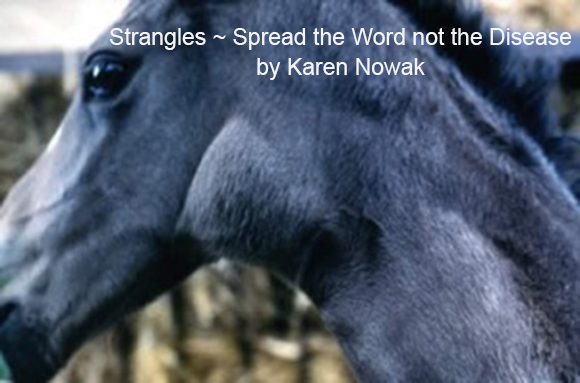
Strangles. The word strikes fear, and sometimes panic, in horse owners. Unfortunately, where fear abounds, misconceptions and misinformation follows. This article will provide an update on strangles, as, through ongoing research, scientists have a much greater understanding about how strangles spreads. Josie Traub-Dargatz, DVM, Dipl. ACVIM, professor of equine medicine and epidemiology at Colorado State University's Veterinary School, is part of the study group that has been making recommendations on the control of equine strangles. Rob Holland, DVM, PhD, a private practitioner and an equine field veterinarian for Pfizer Animal Health, has extensive experience with how strangles is spread. Their findings and recommendations will be included in this article.
What is Strangles?
Strangles is an infectious, very contagious disease of horses, donkeys and mules. It occurs throughout the world and was first reported in 1251! It is caused by the bacteria streptococcus equi, or S. equi for short. It is NOT a virus! The bacteria enters the horse through either the nose or mouth and works its way into the tonsils at the back of the throat then the lymph nodes of the jaw and sometimes the head or neck.
What are the symptoms?
• Fever – is the first sign and begins 3 to 14 days after exposure to S. equi. Rectal temperature will rise to 1030F or higher.
• Runny nose – occurs next, usually from both nostrils. It may be clear initially but quickly becomes thick, opaque and yellow or green in color. It frequently runs almost continuously out one or both nostrils in the first week of the infection. This nasal drainage contains the S. equi bacteria and may infect other horses. See Figure 1 at the end of the article.
• Horses become depressed and tend to stand in one place.
• Loss of appetite due to throat pain.
• Lymph nodes under the head between the jaw bones swell and become hot and painful about a week after the start of fever. Infection may spread to lymph nodes near the eye, causing the eyelids to swell, and/or the lymph nodes on the side of the neck. See Figures 2 and 3.
• As lymph nodes swell, the horse often has difficulty swallowing. The horse may stand with the neck lowered and head extended to relieve throat pain and make breathing easier.
• Serum (clear yellow fluid) may ooze from the skin in the areas of swelling as the infected lymph nodes continue to swell and form abscesses. The abscesses most often rupture, draining a creamy or yellow colored pus. The drainage from abscesses contains the S. equi bacteria and may infect other horses. See Figures 4 and 5.
• Some horses will have a soft cough.
How is Strangles Treated?
Always contact your veterinarian immediately if you suspect your horse may have strangles or has been exposed to strangles. Do NOT attempt to treat it yourself! Your veterinarian will be aware of the latest recommendations for the treatment of strangles.
The use of antibiotics is highly controversial. Some veterinarians may prescribe antibiotics if the horse has been exposed and develops a fever. Most will not prescribe antibiotics if lymph nodes are already enlarged, they will wait until they have abscessed and drained. ALWAYS give prescribed antibiotics exactly as your veterinarian has prescribed! In other words, do NOT stop them because the horse has improved. NEVER treat with antibiotics yourself! Your veterinarian is the person who is aware of the best antibiotic to effectively treat strangles.
Failure to give the prescribed doses of antibiotics or attempting to treat it yourself results in the bacteria not being completely killed. The horse may appear to recover, but then re-infects itself and may infect others. Even worse, the bacteria may become resistant to the antibiotic that had been given, making effective treatment even more difficult and far more expensive!
Your veterinarian may advise you to place warm compresses over swollen lymph nodes to help the abscesses come to the surface and drain. The horse will rapidly improve once they have drained.
Place hay, feed and water buckets low or on the floor to encourage the horse to eat and drink. They may refuse grain and coarse hay due to pain when swallowing. Soft, second cutting hay is easier for them to swallow and will usually encourage them to eat. Making a mash or slurry of grain may encourage them to eat grain but refusal to eat any grain until abscesses have drained is common. Some horses prefer cool water and others warm water. Determine which your horse prefers as water intake is critical when they have a fever.
Their nostrils and nose get very irritated from the continuous drainage – just like ours does when we have a bad cold! Moist cucumber/aloe vera disposable wipes are soothing and help heal irritated skin. You can buy packs of 50 to 100 very inexpensively at dollar stores to wipe their nose with.
How Does Strangles Spread?
Strangles is usually spread by oral contact. Water is the most common route (more on that later) but it may also be spread on tack - particularly bits, lip chains and twitches; mutual head contact between horses, shared feed, feed utensils, contaminated housing and other less obvious sources as the hands, clothing, and equipment of caretakers, handlers, farriers and veterinarians unless appropriate biosecurity precautions are taken.
Apparently healthy horses, who have been exposed but are not yet showing symptoms may spread strangles. Scientists believe that normal nasal secretions harbor the bacteria and spread it to other horses. Horses will continue to shed the bacteria in nasal secretions for 2 to 3 weeks and a moderate number for 4 to 6 weeks after they have recovered from strangles. Proper quarantine of horses after they have recovered will prevent the spread to other horses.
It is now known that approximately 10% of horses who recover from strangles become chronic carriers and may shed the bacteria for months to years after they have recovered. Failure to identify these healthy but chronic carrier horses is now believed to be the cause of periodic outbreaks on farms or outbreaks at shows, clinics and other events where horses congregate from various locations. Fortunately, these horses may be identified and treated by having your veterinarian perform cultures from the glutteral pouch at the back of the horse’s throat. See Figure 6.
Methods to Prevent the Spread of Strangles
1. A hose can carry bacteria from one bucket to another when you dunk the end in each bucket to fill or if you touch the bucket with your hands then touch the hose. Use a separate hose for the horse with strangles and store it just outside the stall. Always wear disposable gloves when filling the bucket of a horse with strangles.
2. S. equi can survive for three to four weeks in water in tanks contaminated by discharges. Shared sources of water, and sharing water hoses is a common way for strangles to be spread.
3. Bacteria shielded in pus from abscesses can live longer than if just contained in a drop of clear watery fluid from the horse's nose.
4. S. equi lives three days in the soil, seven days on a fence post, and 30-40 days in a water trough.
5. In winter, pus and contaminated discharges/bedding that freeze can survive to infect others when the ground thaws.
6. At events, if possible, it is best to leave your horse by your trailer rather than using shared stalls that might be contaminated. If you must use a stall, disinfect it BEFORE placing bedding, buckets and horse in it.
7. Water buckets should NEVER be shared at horse shows! Never allow your horse to drink from a shared water trough at shows, events or on trails.
8. Some horses that continue to shed S. equi past 30 days might clear infections on their own, but it is possible for a horse to shed for weeks, months, or even years.
9. Ask owners of visiting or new resident horses about the strangles status of these horses and consider screening for shedding - most especially if there is a history of strangles.
10. Contaminated pastures should be empty for at least a month before adding other horses.
11. Water tanks, buckets and the discharge end of water should be cleaned/disinfected daily during an outbreak.
12. When possible, assign specific personnel to handle only the sick animals. Clean hands thoroughly with a waterless hand sanitizer after handling each horse. Wash your hands with soap and water before handling/touching uninfected horses, even if you used hand sanitizer. It is the friction of rubbing your wet hands together that is key to removing bacteria so it may be rinsed away.
13. ALWAYS work with sick animals LAST if you are handling healthy and sick horses.
14. Supply disposable coveralls and foot covers or rubber boots that are to be worn only when in contact with sick horses, and set up a specific changing area for putting on protective clothing.
15. Set up foot baths with disinfectant (like Virkon-S or Trifectant) or a 1:10 bleach solution (1 ½ cups Clorox®* per gallon of water) outside the sick horse’s stall and at entrances/exits from the barn. *Avoid bargain brands because they are usually significantly weaker than Clorox®.
16. Use a separate manure fork, shovel, broom and muck bucket for sick horses. Disinfect these items daily and store outside the sick horse’s stall(s).
17. Have a separate contaminated trash can with bag for disposable coveralls, shoe covers, gloves, dressings, etc. A trash can with a foot pedal to open the lid is the best to avoid contaminating your hands. Wear gloves when you empty the trash and place it in a second bag.
18. Isolate manure and bedding from sick horses at least 200 feet from the fence line of other horse pastures and cover with a weighted tarp to prevent flies, birds and/or rodents picking up the bacteria and spreading it to other parts of the farm. Compost manure under the tarp for at least 6 weeks after the horse is removed from quarantine. If wintertime, compost under the tarp until the temperature has been above freezing for 6 weeks. DO NOT spread this manure on pastures or hay fields to be used for forage.
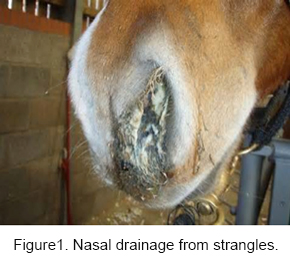
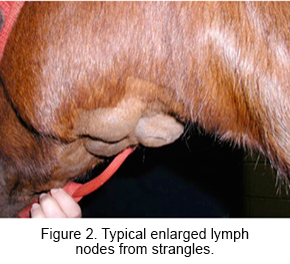
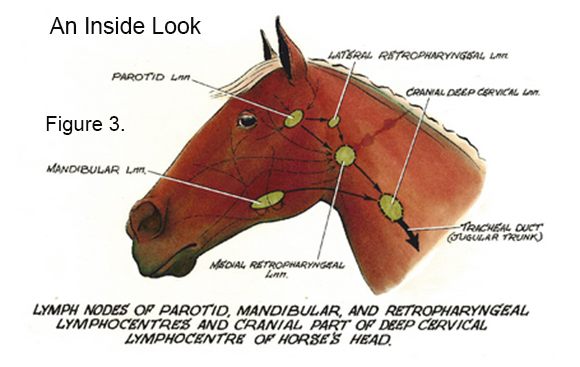
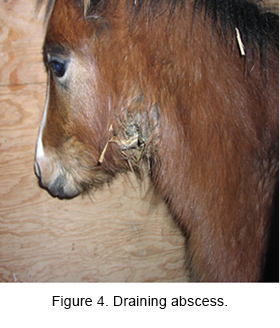
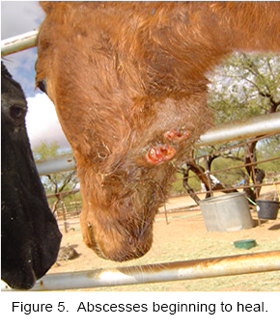
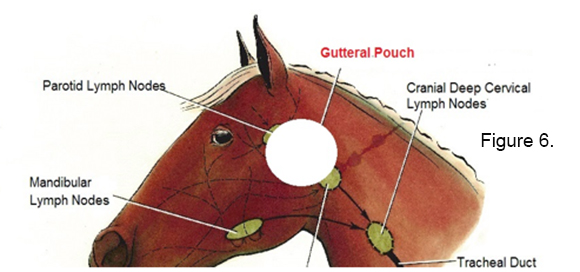
References:
1. Loving, Nancy S., DVM. “Strangles Management and Prevention.” TheHorse.com (November 2007).
2. Traub-Dargatz, Josie DVM, MS, DACVIM, Alanna Kirby. “Strangles: A Contagious Equine Disease.” Respiratory Conditions (August 22, 2007).
3. Smith, Phoebe A., DVM. “How to Eliminate Strangles Infections Caused by Silent Carriers.” AAEP Proceedings (2006); 52:101-103.
4. Unknown. “Strangles.” http://www.aaep.org/info/strangles. Accessed April 27, 2016.
5. Sweeney, Corrine R., John F. Timoney, J. Richard Newton, Melissa T. Hines. “Streptococcus equi Infections in Horses: Guidelines for Treatment, Control, and Prevention of Strangles.” ACVIM Strep equi consensus statement. J Vet Intern Med (2005); 19:123–134.
6. Prescott, John, Bob Wright. “Strangles in Horses Factsheet.” Ontario Ministry of Agriculture, Food & Rural Affairs (April 2003).
7. Newton J.R., J.L.N. Wood, K.A. Dunn, M.N. DeBrauwere, N. Chanter. “Naturally Occurring Persistent and Symptomatic Infection of the Guttural Pouches of Horses with Streptococcus equi.” Vet. Rec. (1997); 140:84-90.
Karen Nowak: President, Brookfield Riding & Driving Association
Owner, Pond Ridge Farm Hackney Horses
Founder, Northeast Hackney Rescue & Sanctuary
Karen has owned and shown horses for over 50 years and has purchased and/or provided foster care, rehabilitation, placement or sanctuary for at-risk and rescue horses for 20 years.
Karen also has 41 years experience as a Critical Care and Emergency Services nurse, including 10 years as the Educator for Critical Care and Emergency Services in a regional hospital education department. She is former instructor in Infection Control for the NYS Fire Academy and was a NYS EMT and Paramedic Instructor for 24 years.


